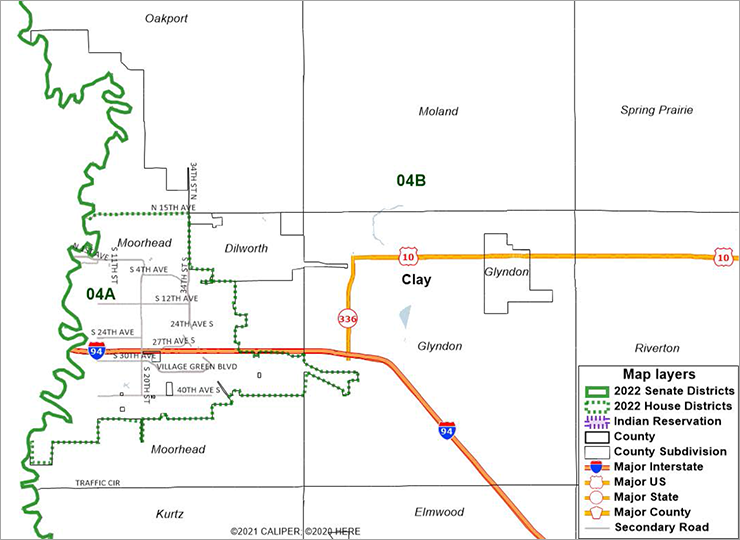The new court-drawn political maps have reshaped Minnesota’s legislative districts, which will determine control of the state House and Senate in 2022 — and for the rest of the decade.
In Greater Minnesota, the maps aren’t likely to spark a huge shift in control of power. Republicans hold most rural seats while the DFL has seen some success in districts centered on bigger cities and college towns. That trend is likely to be similar in 2022 and perhaps beyond.
But that doesn’t mean there aren’t important political developments outside of the Twin Cities metro area. Here are five post-redistricting storylines to watch in Greater Minnesota politics:
Will Rochester elect a Democrat to the state Senate?
For the last decade, Rochester has been split into two Senate districts, both combined with large areas outside of the city. In that time, Rochester has become more Democratic, but voters in the two districts have picked Republican Sens. Carla Nelson and David Senjem, making the city an outlier compared to similar places represented right now by the DFL: Duluth, Mankato, St. Cloud and Moorhead.
But the new political maps might just change that. The district where Senjem lives will include much more of DFL-friendly Rochester than it does now, and much less of conservative-leaning areas outside the city, such as Byron, Kasson and Dodge Center. “It looks like to me it’s gone from being leaning Republican to being a pretty dependable seat for the Democrats,” said Todd Rapp, a Democratic political operative who runs the consulting company Rapp Strategies.
How Senate District 25 changed
The new district where Nelson lives, which includes part of southern Rochester, is also different. But it will now include many of those conservative towns that are currently part of the district Senjem represents and less of Rochester than Nelson’s current district. “I haven’t had actual time to look at all of those numbers, but others who have have indicated that is a more red leaning district,” Nelson said Wednesday.
In 2020, Senjem beat Democrat Sara Flick by 2.5 points, while Nelson beat Democrat Aleta Borrud by 1.9 points. Both Republicans outperformed Donald Trump that year, who lost in both districts to Joe Biden by modest margins. Yet a rough estimate suggests Biden won the new district where Senjem lives by a huge margin in 2020. Trump narrowly won the other Senate district that includes southern Rochester.

Right now in the House, two Democrats and two Republicans represent at least some part of Rochester. That mix might change too. Biden would have won three of Rochester’s four new state House districts by wide margins in 2020.
And one GOP lawmaker who currently represents the northern section of Rochester, Rep. Duane Quam, lives in Byron, according to his legislative biography, which won’t be in the new district that includes more of Rochester.
Republicans could further gains Greater Minnesota
The new maps could also provide more opportunities for Republicans to win House and Senate seats in Greater Minnesota, even though they currently hold the vast majority of them.
The Iron Range district held by independent Sen. David Tomassoni would favor the GOP under the new political maps if the Chisholm senator, who has ALS, retires. The House seats now held by DFL Reps. Dave Lislegard of Aurora, Julie Sandstede of Hibbing and Rob Ecklund of International Falls will also likely be Republican targets to flip. The Moorhead-area Senate seat now held by DFLer Kent Eken will also lean towards the GOP under its new boundaries, based on the 2020 presidential vote.

St. Cloud’s two House seats and one Senate position will also be election battlegrounds.

Musical chairs
Rapp said rural districts cover large geographic areas but have shrinking populations, and are losing districts because growth in metro suburbs and exurbs outpaced Greater Minnesota. That means more districts in and around the metro, and plenty of instances in Greater Minnesota where there are now two sitting legislators in the same 2022 district.
For example, in addition to Nelson and Dornink, Sens. Carrie Ruud of Breezy Point and Justin Eichorn of Grand Rapids are now in the same Senate district, as are Sens. Julie Rosen of Fairmont and Rich Draheim of Madison Lake. In the House, Minority Leader Kurt Daudt of Crown and Rep. Sondra Erickson of Princeton are in the same district, among other pairings.
Nelson said Dornink came in to talk to her after the maps were published, and she told him: “I’m running.” Dornink plans to move to a district that includes far more of the areas he represents in his current district.
A Bemidji-area Senate district with three tribes
One development in the Congressional maps drawn by the court was that the 8th District in northeastern Minnesota expanded far enough west to include the seven Anishinaabe reservations in the state.
In the Legislature, Minnesota’s state Senate District 2 also now includes three tribal nations — White Earth, Red Lake and Leech Lake — that were previously split into two Senate districts. Native Americans will make up a significant bloc district’s population, though it will still be majority white. Sen. Paul Utke, who currently represents the 2nd District, lives in Park Rapids, which will be in a separate district under the new maps. That means there will be no incumbent senator in the new 2nd District, though a sitting legislator could move within the new district boundaries.



0 Commentaires